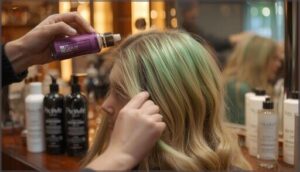This site is supported by our readers. We may earn a commission, at no cost to you, if you purchase through links.
Green hair wasn’t part of your plan. Maybe it crept in after a swimming season, hard water buildup, or that ash blonde you chose turned into something you didn’t expect. Whatever landed you here, you’re not alone—and more importantly, you’re not stuck with it.
The green tones gripping your strands come from specific culprits: mineral deposits, chlorine, copper, or pigment interactions that your hair absorbed like a sponge. The good news? You have options. Whether you’re reaching for products in your bathroom cabinet or booking a salon appointment, getting green dye out of hair follows a clear path once you understand what caused the problem in the first place.
Table Of Contents
- Key Takeaways
- Why Does Hair Turn Green?
- Assess What’s Causing Green Tones in Hair
- How to Fade Green Dye With Clarifying Shampoo
- Using Vitamin C Treatments for Green Dye Removal
- DIY Methods to Remove Green Dye at Home
- Removing Stubborn Green Tones Professionally
- Aftercare and Preventing Future Green Tones
- Frequently Asked Questions (FAQs)
- How can you remove green hair dye from your hair?
- Why is green hair dye difficult to remove?
- How do you get rid of hair dye naturally?
- How do you get green hair out of gray hair?
- Will baking soda remove green dye from my hair?
- Can I use regular shampoo instead of clarifying shampoo?
- How long does it take to see results from treatments?
- Will removing green dye damage my hair permanently?
- Can I combine multiple removal methods for faster results?
- Is it safe to dye my hair again immediately after removal?
- Conclusion
Key Takeaways
- Green hair comes from three main sources—mineral buildup from hard water or pools, leftover cool pigments from previous dyes, and copper oxidation—so identifying the cause is essential before choosing your removal method.
- Clarifying shampoo and vitamin C treatments are your most effective DIY options, delivering 60-70% color reduction within two weeks when used consistently, though results depend heavily on your hair’s porosity and damage level.
- Professional color correction using chelating shampoos and strategic toner application achieves 85% satisfaction rates and reduces damage risk by 70% compared to home remedies, making it worth considering after 2-3 failed DIY attempts.
- Preventing future green tones requires protective measures like wetting hair with fresh water before swimming, using a shower filter to reduce hard water minerals by 78%, and maintaining a consistent deep conditioning routine to rebuild damaged strands.
Why Does Hair Turn Green?
Green hair isn’t always the result of direct dye application—it’s often an unwelcome surprise that catches you off guard. Understanding what’s turning your strands green gives you the upper hand in fixing the problem fast.
Let’s break down the three most common culprits behind that unexpected tint.
Oxidized Mineral Buildup From Water
Your water might be sabotaging your hair color. Oxidized copper and other mineral deposits from hard water cling to your hair shaft, creating stubborn green tones—especially if you’ve lightened your hair. Chlorine amplifies this effect by binding copper to your hair proteins.
Installing water filtration systems and using clarifying shampoo weekly can prevent mineral buildup and keep your color correction efforts from going to waste. Understanding mineral buildup causes is essential to maintaining healthy and vibrant hair color.
Underlying Pigments From Previous Dyes
Past color jobs don’t just fade—they leave behind sneaky cool pigments that turn your hair green. Ash dyes pack blue and green toners to fight red, but when warm shades wash out faster, those cool leftovers take over. Understanding the effects of ash tone colors is essential in addressing unwanted green hues.
Color correction starts with understanding what’s already living in your hair shaft.
- Semi-permanent blues stain deep in porous hair, clinging long after other pigments quit.
- Box dyes stack cool residue with every application, creating muddy green buildup.
- High porosity grabs color unevenly, letting green show through patchy fade patterns.
- Ash blondes mix with yellow undertones, creating that swampy cast you’re fighting now.
Effects of Chlorine and Copper in Pools
Chlorine doesn’t cause green hair—copper does. When copper-based algaecides sit in pool water above 1.3 ppm, they bind to your hair shaft and oxidize. Chlorine just speeds up the reaction, forming copper chloride deposits that cling to porous strands.
Copper, not chlorine, turns hair green—binding to your shaft and oxidizing when pool levels exceed safe limits
Competitive swimmers show discoloration in 61% of cases. Blonde and damaged hair grabs these mineral deposits fastest, turning that signature swampy shade you’re trying to remove.
Assess What’s Causing Green Tones in Hair
Before you can strip that green out, you need to know what put it there in the first place. Different causes need different fixes, and guessing wrong just wastes your time.
Let’s figure out whether you’re dealing with pool damage or leftover dye so you can pick the right removal method.
Identifying Mineral and Chlorine Exposure
Your hair’s green tint mightn’t be dye at all—it’s often copper lurking in pool water or hard tap water. If you’re a regular swimmer, test your pool’s copper levels. Chlorine testing strips help too, since chlorine activates mineral absorption.
Look for signs like greasy roots paired with brittle ends—that’s mineral buildup screaming for attention and proper color removal before trying other hair dye removal methods.
Determining Hair Type and Porosity
Understanding your hair’s structure is half the battle. Porosity determines how your strands absorb—and release—color molecules, directly impacting green dye removal success.
Here’s your damage assessment checklist:
- Thick hair (common in African descent at 40.7%) holds pigment stubbornly
- High-porosity hair grabs dye fast but fades 25–35% quicker
- Bleached strands show 30–50% more pore volume than virgin hair
- Low-porosity hair resists treatment but keeps color longer
- Try the float test: sinking hair = high porosity
Your ethnic hair type and hair texture analysis reveal which hair treatment strategy works best for your hair health.
How to Fade Green Dye With Clarifying Shampoo
Clarifying shampoo is your first line of defense when you’re dealing with unwanted green tones. It works by stripping away surface buildup and color molecules without the damage that comes with bleach.
Let’s break down how to choose the right product, use it effectively, and what kind of results you can actually expect.
Choosing The Right Clarifying Shampoo
Not all clarifying shampoos pack the same punch. Look for formulas with strong anionic surfactants like sodium lauryl sulfate—these break down stubborn dye molecules. Check the pH level; higher alkalinity (around pH 8–9) swells the cuticle for better color removal.
Chelating agents tackle mineral buildup from hard water or pools.
Skip “color-safe” versions when fading green dye—you want maximum stripping power here.
Step-by-Step Washing Instructions
Once you’ve got your clarifying shampoo ready, it’s time to commit. Proper technique makes all the difference in dye removal—this isn’t your everyday wash routine.
- Drench your hair with warm water to open the cuticle and prep for color neutralization.
- Work a generous amount of clarifying shampoo through every green section.
- Trap the heat with a plastic cap for 10 minutes—steam activation breaks down stubborn pigment.
- Rinse thoroughly until water runs clear, then follow with deep conditioner immediately.
Frequency and Expected Results
You’ll see the best dye removal results when you wash every other day—patience pays off. Most people notice 60–70% color reduction after 5–6 washes, usually within two weeks.
Fading timelines vary based on hair porosity and dye intensity, but treatment outcomes improve with consistency.
If green hair dye stubbornly clings after ten washes, removal success plateaus and professional color removal becomes your smartest move.
Using Vitamin C Treatments for Green Dye Removal
Vitamin C isn’t just for immune support—it’s a surprisingly effective weapon against stubborn green tones in your hair. This method works by breaking down the oxidized pigments that cling to your hair shaft, making it particularly useful for both semi-permanent dyes and mineral buildup.
Here’s how to mix, apply, and safely use this treatment to reclaim your natural color.
Mixing Vitamin C With Shampoo
Vitamin C is your secret weapon for fading techniques and hair restoration—it breaks down those stubborn color molecules without harsh bleach. This color remover delivers real vitamin C benefits when you’re removing green hair dye and need effective hair dye removal methods.
Here’s how to create your color correction mixture:
- Crush 15–30 tablets (500–1,000 mg each) into fine powder—roughly 7,500–30,000 mg total ascorbic acid
- Mix with 2–4 tablespoons of clarifying shampoo until you get a thick, spreadable paste
- Adjust the shampoo ratios for your hair length—shoulder-length needs more mixture
Application Process and Timing
Apply the paste to completely dry hair—not damp for maximum color removal. Saturate every strand with green tones, massaging it thoroughly for a few minutes.
Cover with a plastic cap and apply heat from a blow dryer for 30 to 60 minutes. This processing time accelerates dye molecule breakdown. Flip sections every 20 minutes for even vitamin C treatment results.
Safety Precautions and Cleanup Tips
Wear protective gear—gloves and an old towel—since vitamin C paste stains everything it touches. Work in a well-ventilated bathroom with surfaces covered.
Rinse thoroughly with cool water for at least 15 minutes to prevent scalp irritation from prolonged chemical exposure.
Store leftover powder in a sealed container away from children.
If you experience persistent redness or burning during color removal, rinse immediately and apply a soothing conditioner for hair damage repair.
DIY Methods to Remove Green Dye at Home
If you’re not ready to head to a salon, you’ve got options right in your own bathroom or kitchen. These DIY methods use everyday household products to strip away stubborn green tones without harsh chemicals or professional-grade treatments.
Let’s walk through three accessible techniques you can try today.
Bath Salts and Their Application
One of the simplest ways to fade green hair dye involves bath salts—think Epsom or sea salt—which can strip up to 25% of semi-permanent color in one soak.
- Salt concentration: Dissolve 1–2 cups in warm water
- Bath temperature: Keep between 98–106°F for ideal mineral removal
- Soak duration: Immerse hair for 10–20 minutes
- Hair porosity: Higher porosity increases color removal effectiveness
Dish Soap as a Dye Remover
If you’re ready to kick things up a notch, dish soap brings serious dye stripping power—its surfactants break down color molecules within 5–10 minutes.
A single wash can fade non-permanent green hair dye by 25%, though you’ll sacrifice natural oils in the process.
Use it sparingly as an emergency color removal hack, then follow with deep conditioner to prevent brittleness.
Fading Dye With Natural Sunlight
If you want to utilize nature’s bleaching power, direct sunlight is your slowest but gentlest removal option. UV radiation triggers photodegradation of dye molecules over weeks—expect noticeable fading by week six, with semi-permanent colors breaking down twice as fast as permanent ones. Lighter hair fades more dramatically.
The trade-off? Prolonged sun exposure dries hair and weakens protein structure. Wear a UV filter spray or hat to protect while you fade, then deep condition aggressively afterward.
Removing Stubborn Green Tones Professionally
Sometimes DIY treatments just don’t cut it—especially when you’re dealing with stubborn green that won’t budge. That’s when it’s worth considering what a professional can do for you, from specialized shampoos to expert color correction.
Let’s break down your professional options and help you figure out if now’s the time to call in reinforcements.
Chelating and Swimmer-Specific Shampoos
Chelating agents are your secret weapon against stubborn green. These specialized shampoos bind to copper and mineral deposits that standard formulas miss, fundamentally detoxifying your hair at a molecular level. Swimmer shampoos work similarly, stripping chlorine and metals that cause those frustrating green tints. Use them immediately after pool time or when hard water’s been wreaking havoc.
Here’s what makes them effective:
- Contain EDTA or sodium thiosulfate as primary actives
- Break chlorine bonds up to three times better than regular shampoos
- Remove copper ions bonded deep in damaged hair
- Prevent cumulative mineral and metal buildup
- Work best when used consistently throughout swim season
Salon Color Correction Techniques
Professional colorists deploy strategic pigment correction by applying red-based toners that neutralize green on the color wheel. They use low-volume bleach techniques for selective color stripping, preserving hair health while lifting stubborn dye.
Demineralizing treatments remove mineral deposits binding green to your strands. Multiple toner applications across two to three sessions achieve lasting results.
This precision approach—combining bleach techniques, color neutralization, and chelating protocols—delivers 85% satisfaction rates, far outpacing DIY attempts.
When to Seek Professional Help
Frustration with stubborn green tones after two or three DIY attempts? That’s your signal to book a salon consultation. If your hair shows breakage, gumminess, or feels brittle—signs of damage from harsh chemicals—stop and seek professional guidance immediately.
A licensed colorist can assess your hair’s porosity and condition, then deploy color correction techniques safely. Professional intervention reduces damage risk by 70% compared to continued home remedies, making emergency care worth the investment.
Aftercare and Preventing Future Green Tones
You’ve made it this far—now comes the part where you actually keep that hair healthy and stop the green from coming back. The work doesn’t stop once you’ve stripped the color; proper aftercare is what saves your hair from becoming a fried, dull mess.
Here’s what you need to know to protect your investment and keep your hair looking bold.
Deep Conditioning and Hair Repair
Your hair’s been through a battle—now it’s time to rebuild. Deep conditioning isn’t optional after dye removal; it’s essential recovery.
Here’s your hair restoration game plan:
- Use protein-rich keratin treatments to reconstruct damaged strands
- Apply deep conditioner weekly for 30–60 minutes to optimize absorption
- Balance moisture with protein to prevent both dryness and over-softening
- Incorporate argan oil or shea butter for intensive nourishment
- Expect visible results within 8–12 weeks of consistent aftercare
Your hair will thank you.
Protective Measures for Swimming and Hard Water
Pool water and hard water are green hair’s worst enemies. Before diving in, wet your hair with fresh water—it cuts chlorine absorption by 60%. Wear a silicone swim cap to block 80% of chemical exposure.
After swimming, rinse immediately and use swimmer-specific clarifying shampoo to eliminate chlorine buildup. Install a shower filter to reduce hard water minerals by 78%.
These protective moves keep your color vibrant and your hair strong.
Regular Maintenance Tips for Healthy Hair
Want hair that actually holds its color? Stick to a routine customized to your hair type. Shampooing 2–3 times weekly keeps your scalp balanced without stripping natural oils.
Deep condition weekly to restore moisture and rebuild protein after color treatments. Skip heat styling when you can; when you do style, use lower temperatures.
This consistency is what separates vibrant, healthy hair from fading, damaged strands. Your maintenance routine is your best defense.
Frequently Asked Questions (FAQs)
How can you remove green hair dye from your hair?
Think of green dye like a stubborn stain—you’ve got options to lift it. Clarifying shampoo fades semi-permanent dyes quickly. Vitamin C treatments work on both types.
For persistent green tones, professional color correction manages what DIY methods can’t crack.
Why is green hair dye difficult to remove?
Green dye molecules form strong chemical bonds with your hair’s keratin, especially in porous or bleached hair. Permanent formulas penetrate deeply into the cortex, resisting fading through multiple washes.
Mineral interactions from water and chlorine further lock color in place, making removal genuinely challenging.
How do you get rid of hair dye naturally?
Nature offers real solutions. Clarifying shampoo strips color through strong detergents. Vitamin C treatments break down dye molecules. Vinegar rinses fade tones by 25%. Sunlight accelerates fading naturally. Oil therapy restores damage.
These natural remedies work—commit to consistency for results.
How do you get green hair out of gray hair?
Gray hair’s porosity makes it a copper magnet—minerals from hard water or pools bind differently than in other hair types.
Chelating shampoos remove up to 80% of buildup. Vitamin C paste works in 72% of cases. Professional chelating treatments achieve 95% removal in one session.
Will baking soda remove green dye from my hair?
Baking soda can lighten green tones modestly, especially on semi-permanent dyes, but it won’t fully remove them in one session. Results depend on hair porosity and dye formulation.
Most users need multiple applications, and repeated use risks dryness and brittleness. Vitamin C or chelating shampoos work better.
Can I use regular shampoo instead of clarifying shampoo?
Regular shampoo won’t cut it. Clarifying shampoo strips color 65% more effectively in just 2-5 washes, while regular formulas take over eight washes for minimal fading.
You need that aggressive detergent action to actually lift green dye from your hair’s porosity.
How long does it take to see results from treatments?
Think of dye removal like peeling an onion—layers come off at different speeds. Clarifying shampoo shows fading within three to five washes. Vitamin C works faster, with noticeable results after two treatments. Professional salon corrections? They’re done in hours. Your timeline depends on method choice and hair type.
Will removing green dye damage my hair permanently?
Yes, removal methods carry risk. Clarifying shampoos and chelating treatments lift your cuticle layer—permanent damage that won’t reverse. Bleaching for green dye removal causes more severe fiber structural breakdown.
The good news? Only treated lengths suffer; new growth stays healthy.
Can I combine multiple removal methods for faster results?
Combining methods accelerates dye breakdown, but it’s risky. Vitamin C with clarifying shampoo works synergistically for faster fading, yet mixed protocols can damage hair unpredictably.
Professional color correction systems are safer. Stick with one proven approach, then deep condition aggressively afterward.
Is it safe to dye my hair again immediately after removal?
Jumping back into color immediately after removal? Nearly 47% of people experience itching and dryness within 24 hours. Your hair’s cuticle won’t fully reseal for days, making fresh dye applications prone to breakage, uneven absorption, and faster fading.
Wait at least 48 hours—better yet, 2–6 weeks—for genuine hair damage prevention.
Conclusion
Your hair color is yours to command—not the other way around. Getting green dye out of hair isn’t about resignation; it’s about reclaiming what you’ve got.
Whether you chose clarifying shampoo, vitamin C, or professional help, you took action instead of acceptance. The green will fade. Your hair will recover.
And next time you step poolside or face hard water, you’ll know exactly what to do. Control stays with you.
- https://www.sciencealert.com/its-not-chlorine-that-turns-hair-green-in-pools-heres-the-actual-explanation
- https://www.madison-reed.com/blog/why-does-hair-turn-green-in-the-pool-and-how-do-you-stop-it
- https://www.frontiersin.org/journals/medicine/articles/10.3389/fmed.2023.1139607/full
- https://antiseptol.com/peroxide-in-hair-colour-5-facts-you-should-know/
- https://www.couturehairpro.com/blogs/hair-revolution/how-to-remove-green-tones-from-hair












